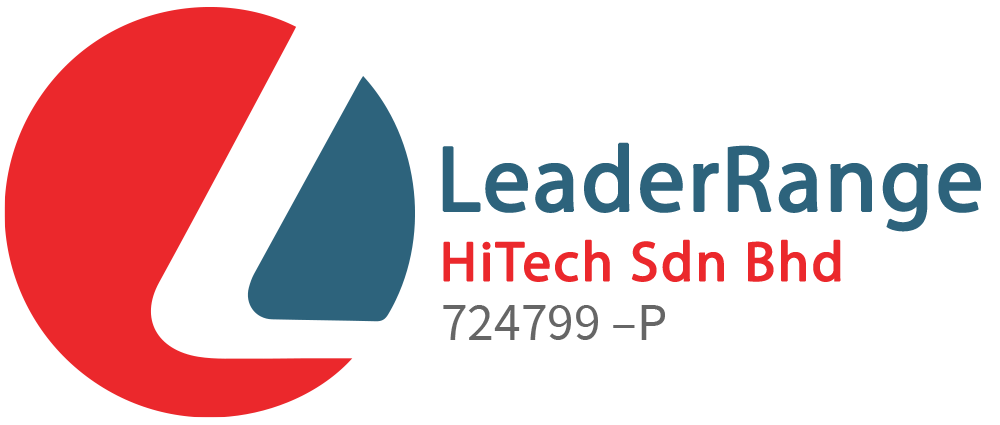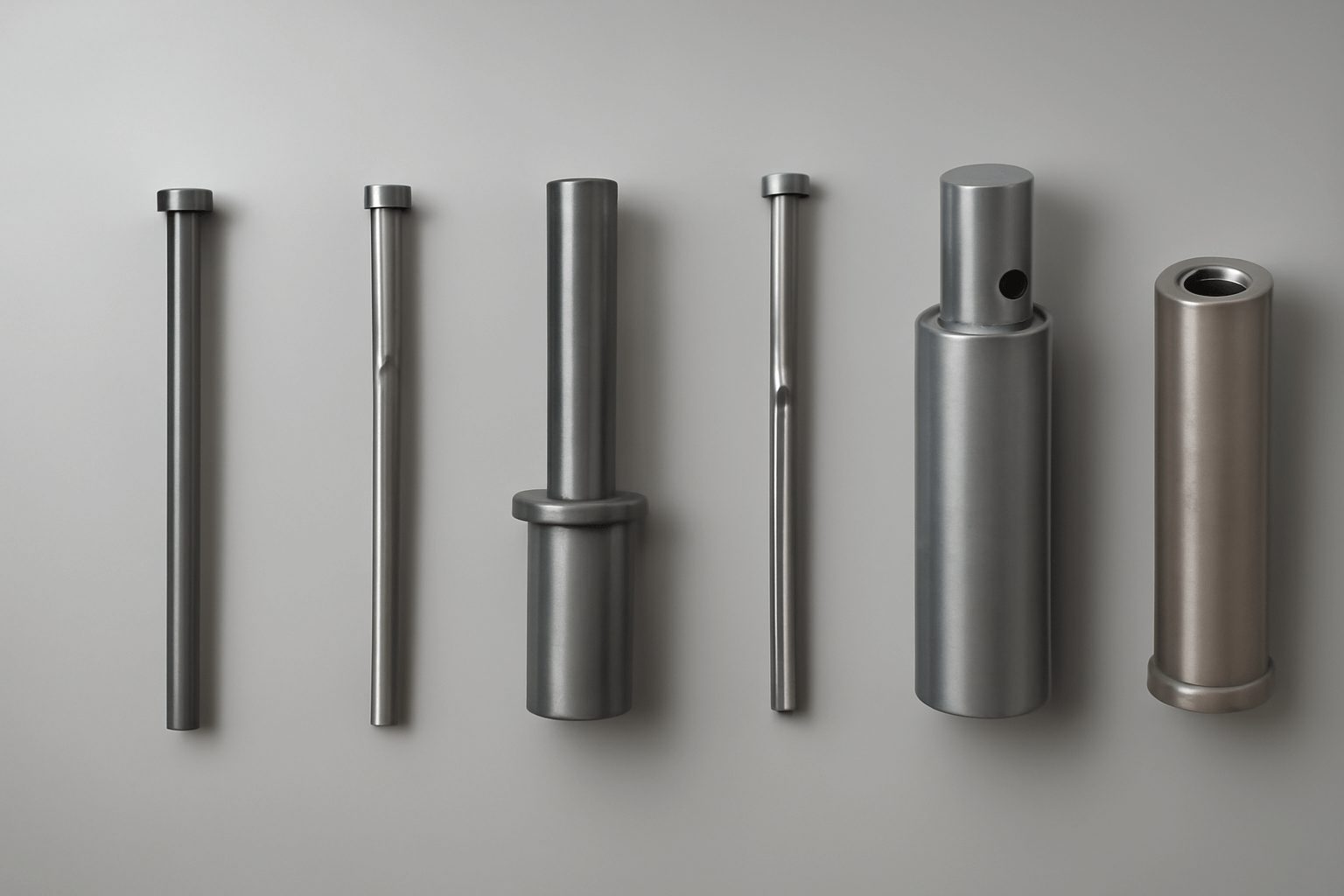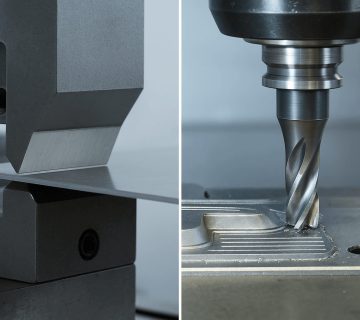In injection molding, ejector pins are integral components that ensure smooth, efficient part ejection from the mold. They come in various types, each with unique designs and applications that make them suitable for different molding requirements.
This article will compare the most common types of ejector pins, such as Straight Ejector Pins, Stepped Ejector Pins, Free Flange-Position Ejector Pins, and others, explaining when to use each based on part design, material, and mold complexity.
1. Straight Ejector Pins
Straight Ejector Pins are the most basic and commonly used type of ejector pin in mold making. These pins provide straightforward ejection in a linear direction, making them suitable for parts with simple geometries. Straight ejector pins are easy to install and cost-effective, which is why they are widely used in standard injection molding operations.
Applications: Use straight ejector pins when the molded part has a simple, uniform design with minimal undercuts or complex features. They are ideal for molding softer materials like plastics or rubber and are frequently used in mass production for products that don’t require specialized ejection mechanisms.
2. Stepped Ejector Pins
Stepped Ejector Pins feature a stepped design that allows for multiple levels of ejection, making them ideal for parts with thicker sections or complex geometries. These pins are particularly useful for ejecting parts with varying depths or cavities and help prevent issues like part deformation during the ejection process. The stepped design allows for precise control over the ejection force and direction, ensuring a smoother and more reliable process.
Applications: Choose stepped ejector pins for multi-cavity molds or when dealing with thicker, more complex parts. They are often used in molds with varying section thicknesses, deeper cavities, or multi-layered components, where a standard straight pin would be insufficient.
3. Free Flange-Position Ejector Pins
Free Flange-Position Ejector Pins are designed with a flange at one end that is not fixed to the mold, allowing for enhanced flexibility during the ejection process. These pins are beneficial when ejecting parts with intricate features, such as undercuts or delicate designs. The free flange provides additional support to the part during ejection, reducing the risk of deformation or damage to the molded product.
Applications: Use free flange-position ejector pins for molds with complex designs that include undercuts, intricate shapes, or delicate features. They are particularly useful for high-precision molding applications where part integrity and surface finish are critical.
4. Pusher Pins
Pusher Pins are typically used in molds where parts need to be pushed or displaced from a specific angle, especially in situations where a direct ejection might not be possible. Pusher pins are often used in combination with other ejector pins to assist in the removal of parts that are stuck or require a more controlled ejection mechanism.
Applications: Pusher pins are ideal for molds with parts that need to be pushed out at an angle or for removing components that may have stuck to the cavity walls due to their shape or material properties. They are often found in complex multi-cavity molds or molds that require angled ejection forces.
5. Ejector Blades
Ejector Blades are flat, wide pins used to eject parts that have larger surface areas. These blades help apply uniform force across the part, ensuring that it is ejected without damaging delicate features. Ejector blades are particularly useful for large parts that require smooth, even ejection force.
Applications: Ejector blades are typically used for larger or flatter parts, such as panels or enclosures, where even ejection across a wide surface is required. These are also essential for parts that are prone to warping or distortion if subjected to uneven ejection forces.
6. Air-Jet Valves
Air-Jet Valves are used in conjunction with ejector pins to improve part ejection, especially when trapped air creates resistance. These valves use compressed air to blow out air pockets, reducing the friction between the part and the mold. This allows for a smoother and faster ejection process, especially in molds where parts are tightly fitted or have deep cavities.
Applications: Use air-jet valves in molds where trapped air may obstruct smooth ejection. These are particularly effective in complex molds or when molding materials that create significant air pockets during cooling.
7. Pins for Ejector Blocks
Pins for Ejector Blocks are a specialized type of ejector pin used in conjunction with ejector blocks. These pins are essential for ensuring that the ejector mechanism works efficiently in multi-cavity molds, where multiple parts are ejected simultaneously. The pin setup in the ejector block provides support and precise control over the ejection process.
Applications: Pins for ejector blocks are used in high-volume, multi-cavity mold setups, where consistent and synchronized ejection is required. These pins ensure smooth and uniform ejection, particularly in molds with several parts or cavities.
Choosing the Right Ejector Pin for Your Mold Design
Selecting the correct ejector pin manufacturer and the appropriate pin type is critical for optimizing mold design and achieving high-quality production. Factors such as part geometry, material properties, mold complexity, and ejection forces play a crucial role in determining the best ejector pin for your mold. Straight ejector pins work well for simple designs, while stepped and free flange-position pins are better suited for more complex parts. Pusher pins, ejector blades, air-jet valves, and pins for ejector blocks all provide specialized solutions for specific molding needs.
By understanding the different types of ejector pins and their applications, manufacturers can make informed decisions, leading to more efficient, reliable, and cost-effective molding operations.


